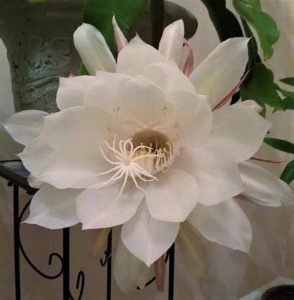
Late spring, friends set a new planter out by their front door with cuttings of a few dark green stems. Their distinctive shape—a familiar image—made my heart leap to joy. Epiphyllum oxypetalum! I hadn’t seen them since moving to the States.
They are a type of cactus. In warmer climates, they can be grown outdoors. More often, they are kept as container plants. The flowers are about the size of a child’s face. Oxypetalum, the ones with white flowers, are commonly grown in South Asia and China. What makes them special is the fact that they only bloom at night. As soon as the flowers open fully, they will begin to close up. The flowers are extremely fragrant: elegant yet permeating. They are often called “queen of the night” and in Chinese “beauty under the moon” (月下美人).
Dad kept an epiphyllum near our front porch. It was about four feet tall, supported by a few bamboo sticks. Whenever tiny red buds appeared at the leave joints, the excitement of anticipation began. The buds would first extend a few inches. Then their stems would gradually thicken, lengthen and start to shape like ladles. The small cone-shape buds would swell up like stretched-out cotton candies.
We would be allowed to stay up late watching the unfolding of the blooms—a silent ceremonial dance, as if the flowers knowingly took their time, savoring the admiration from the audience and giving away their power of beauty only reluctantly. Often, we would invite friends and neighbors over for the special occasion. They would arrive shortly before the moment of full bloom. Photos would be taken. The house would be filled with joyful noises and perfuming scents, as the flowers retreated into their own world.
With good care, my friend’s new plant branched out quickly and bloomed twice within weeks, bringing memorable evenings for their young family. Chinese people use the idiom 曇花一現, literally “an appearance of epiphyllum,” to describe a fleeting moment of glory or fortune. No matter how long a beautiful thing will last, it is up to us to treasure its existence.
